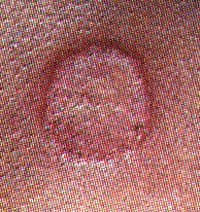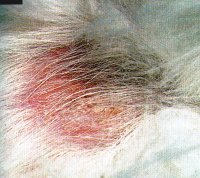
WHAT IS "RINGWORM" First broadcast on www.provet.co.uk |
This information is provided by Provet for educational purposes only.
You should seek the advice of your veterinarian if your pet is ill as only he or she can correctly advise on the diagnosis and recommend the treatment that is most appropriate for your pet.
Ringworm is a common infection of the skin of animals and man ...but it isn't what its name suggests it is !
Ringworm is caused by a fungal infection of the skin, hairs or nails...so it isn't caused by a "worm", and, although the lesions it causes can take on a circular "ring" shape (particularly in humans), in animals it usually takes the form of a circular, dry, raised,crusty lesion with hair loss - often on the head or feet. In cattle and horses the disease causes multiple, large, grey, crusty lesions.

The typical "ring" shaped lesion seen in humans

A typical inflamed, crusty lesion with hair loss as seen in a cat
(Photograph reproduced with the permission of Manson Publishing from "Skin Diseases of the Dog and Cat" by Harvey and McKeever .
Three different genera of fungi are involved : Microsporum spp, Trichophyton spp and Epidermophyton spp (rare) and M.canis is the most common cause in small animals (even in cats). T.verrucosum is the most common cause in cattle, and T.equinum and M.equinum are the most common causes in horses.
These fungi can be isolated from normal cat skin and hair, especially show cats and those kept in colonies. The disease is most common in young animals and old animals which have some degree of immune problem. Unless the animal has very poor immune defences it will overcome the infection itself , however this disease is a zoonosis ie it can be spread to humans, so it must be treated with medication.
The infection can be spread by direct contact with the lesions, with spores on the animal or in the environment, and by indirect contact through grooming implements (combs, brushes) or shared equipment such as collars or saddles.
Diagnosis is confirmed by laboratory examination of affected hair shafts and/or culture in special medium (Sabourauds). Some of the fungi involved (M.canis) fluoresce a bright green colour when an ultraviolet light (called a Woods lamp) is shone on the lesion, but this test does not work for all forms of the disease.
Treatment involves clipping the affected area and burning the hair, then treatment with an antifungal drug called griseofulvin for 4-6 weeks. This drug can not be used in pregnant animals. Sometimes other drugs are used as well. The environment in which the animal lives should be vacuumed and where possible cleaned with bleach.
Updated October 2013